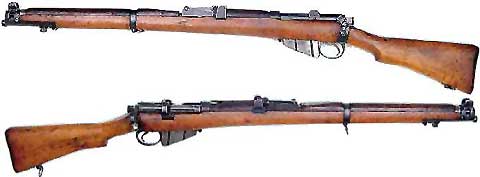The Lee Enfield

Introduction
Click on the expanded Lee Enfield menu in the left column of the website or use the links below.
| Model & Marks | SMLE MkII | Enfield Rifle 7.62x51mm |
| MLE | SMLE MkIII | Ishapore 2A/2A1 |
| LEC | SMLE MkV | No 4 Mk1 T Sniper rifle |
| MLE Mk1 & 1* | No. 4 Mk I | EM2 |
| CLLE | No 5 MkI | |
| SMLE MkI | No 4 MkII |
The iconic Lee-Enfield rifle, the SMLE Mk III, was introduced on January 26, 1907, and featured a simplified rear sight arrangement and a fixed, rather than a bolt-head-mounted sliding, charger guide. The design of the handguards and the magazine were also improved, and the chamber was adapted to fire the new Mk VII High Velocity spitzer .303 ammunition. Many early model rifles, of Magazine Lee Enfield (MLE), Magazine Lee Metford (MLM), and SMLE type, were upgraded to the Mk III standard. These are designated Mk IV Cond., with various asterisks denoting subtypes.
During World War I, the standard SMLE Mk III was found to be too complicated to manufacture. Demand was outstripping supply, and in late 1915, the Mk III* was introduced, which incorporated several changes, the most prominent of which were the deletion of the magazine cut-off, and the long range volley sights. The windage adjustment capability of the rear sight was also dispensed with, and the cocking piece was changed from a round knob to a serrated slab. Rifles with some or all of these features present are found, as the changes were implemented at different times in different factories and as stocks of preexisting parts were used. The magazine cut-off was reinstated after WWI ended, and not entirely dispensed with until 1942.
The inability of the principal manufacturers (RSAF Enfield, Birmingham Small Arms, and London Small Arms) to meet military production demands led to the development of the "peddled scheme", which contracted out the production of whole rifles and rifle components to several shell companies, leading to a minor political scandal.
The Lee-Enfield bolt operating system differed greatly from that of most other bolt action rifles of the period. The bolt locking lugs were at the rear of the bolt rather than at the face as with rifles using the Mauser system. Although this meant that the action was weaker in theory, in practice it proved to be rugged and reliable. This feature, combined with a relatively short bolt throw and a 10 round magazine created what was the fastest operating military bolt action rifle of the period. Opposing troops often when facing a small, professional British or Anzak Expeditionary Force armed with this rifle were reluctant to attack this force believing they were facing massed machine-guns. They could not believe that the heavy fire from such a small force was in fact rifle fire.
The SMLE Mk III* (redesignated Rifle No.1 Mk III* in 1926) saw extensive service throughout World War II as well, especially in the North African, Italian, Pacific and Burmese theatres in the hands of British and Commonwealth forces. Australia and India retained and manufactured the SMLE Mk III* as their standard-issue rifle during the conflict, presumably due to familiarity with the design and ease of production, and the rifle remained in Australian military service through the Korean War, until it was replaced by the L1A1 SLR in the late 1950s. (The Lithgow Small Arms Factory finally ceased production of the SMLE Mk III* in 1953.)
The Lithgow Small Arms Factory is a military small arms factory located in the town of Lithgow, New South Wales in Australia. Opened on June 8, 1912, the factory initially manufactured Short Magazine Lee-Enfield Mk III rifles (and bayonets thereof) for the Australian military during WWI, expanding production during WWII to include Vickers machine guns, Bren Guns, various artillery pieces and field guns, and (from the 1950s) the L1A1 SLR rifle, before branching out into sporting goods (including civilian firearms and golf clubs), tools, sewing machines, and similar products. The factory was later acquired by Australian Defence Industries (now Thales Australia) and, as ADI Lithgow, continues to manufacture the F88 Austeyr rifle currently used by the Australian military, as well as small arms ammunition and propellants for both the military and civilian markets.
The infant National Army of Ireland adopted the SMLE as their service rifle upon the foundation of the state in 1922. Captured examples had already seen widespread service with the Irish Republican Army during the War of Independence. The weapon was used by both sides during the Civil War period, and examples were still being used by the IRA during the 1950s, 60s and 70s.
Introduced on the 26th January 1907, the Mk.III rifle incorporated several changes from earlier marks. The front sight was changed to a simple blade instead of a barleycorn. The rear sight bed was widened, a fine adjustment wormwheel was added to the sight leaf and the rear aperture was changed from a "V" to a "U" notch. The receiver was fitted with a charger bridge and the charger guide on the bolt head was abandoned. In 1916 in an effort to reduce the time taken to manufacture the rifle, the rifles could embody any of the following modifications: omission of the longe range sight, alteration of the contours of the striker, and omission of the piling swivel lugs. The Mark III* rifle was introduced on the 2nd January 1916, the only difference being the omission of the magazine cut-off.Scorned by firearms experts when first introduced the Short Magazine Lee Enfield was thought to be too short to be accurate and too long to be a cavalry rifle. The rifle was held to be "nothing but an abortion devised by unscrupulous government technicians by the simple expedient of robbing , whenever possible, every good feature from other rifles and then ruining them". Despite its critics however, the rifle was to become, in its later marks, arguably the finest military bolt action rifle to see service. Manufactured in large quantities during the First World War, the Mk.III and III* rifles were used extensively by British Commonwealth forces in both World Wars.
The SMLE was very advanced in it's day, the early 1900s to late 1950s. It was unusual for a rifle in WWI to have a detachable 10 round magazine not unlike that of modern battle rifles. Although the rifle was designed to use a detachable magazine it also was designed to take a stripper clip and even single rounds. The action on the No.1 is excellent and very fast. In most circles it is well established that the SMLE has the fastest cycling bolt action style action of all battle rifles. The sights on the No.1 are some of the best protected ever designed. Both the front and back sights have large metal lugs on either side. Adjusting the sights are easily accomplished by sliding the elevation up and down the gradient. There is also a small micro adjustment on the rear sight so that you may adjust the rifle to a very minute level by turning the "backsight, fine adjustment worm wheel" one click, each click represents a change of only 5 yards.
Specifications of the Mark III and Mark III*
Caliber................303 Inch (174 Gr. cupro-nickel jacketed, MK VII)
Overall length....44.5 inches (length varied + or - 1 inch depending on butt stock which came in three sizes)
Barrel length.......25.19 inches
Feed device.........10 round detachable box, charger (stripper) loaded
Muzzle velocity..2440 Feet/Second
Weight.................8.62 lbs
Note on nomenclature: It should be noted that the correct WWI nomenclature for this weapon is Rifle, Short Lee-Enfield Mark III (or MK III*). It wasn't until 1926 that the weapon was renamed Rifle No. 1, Short, Magazine Lee-Enfield Mark III (or MK III*)
There are numerous Lee Enfield rifles.
Click on the Lee Enfield menu in the left column of the website or use the links below.
| Lee Enfield Rifles |






